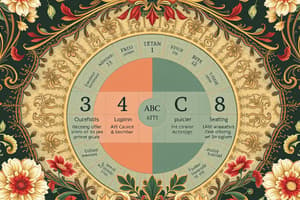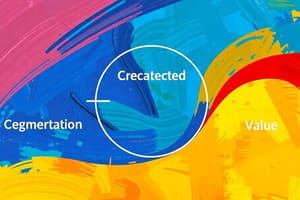Podcast
Questions and Answers
What does Customer Lifetime Value (CLTV) primarily measure?
What does Customer Lifetime Value (CLTV) primarily measure?
- Comparative analysis between different customer segments
- Customer satisfaction with a single product
- The total revenue expected from a customer over their relationship (correct)
- The immediate revenue from a single transaction
Which factor is NOT considered a challenge of customer segmentation?
Which factor is NOT considered a challenge of customer segmentation?
- Gathering customer feedback for product improvement (correct)
- Ensuring data quality and completeness
- Maintaining segment relevance over time
- Choosing the correct segmentation algorithm
What is the primary purpose of visualizing results in customer segmentation?
What is the primary purpose of visualizing results in customer segmentation?
- To instigate regular data entry tasks
- To understand patterns and insights within segments easily (correct)
- To minimize the need for segment evaluation
- To confuse competitors in marketing strategies
Which metric is least relevant for assessing segment profitability?
Which metric is least relevant for assessing segment profitability?
What is essential to ensure when defining meaningful segments?
What is essential to ensure when defining meaningful segments?
What is the primary purpose of customer segmentation?
What is the primary purpose of customer segmentation?
Which method does not require specifying the number of clusters beforehand?
Which method does not require specifying the number of clusters beforehand?
What type of data is primarily focused on values, interests, and lifestyle when segmenting customers?
What type of data is primarily focused on values, interests, and lifestyle when segmenting customers?
Which of the following is a benefit of customer segmentation?
Which of the following is a benefit of customer segmentation?
Which clustering algorithm creates a hierarchical structure for analyzing clusters?
Which clustering algorithm creates a hierarchical structure for analyzing clusters?
What is an example of behavioral data used in customer segmentation?
What is an example of behavioral data used in customer segmentation?
What is the effect of improved targeting due to customer segmentation?
What is the effect of improved targeting due to customer segmentation?
Which variable allows businesses to understand customers' preferred modes of communication?
Which variable allows businesses to understand customers' preferred modes of communication?
Flashcards
Customer Lifetime Value (CLTV)
Customer Lifetime Value (CLTV)
A measure of the total revenue a customer is expected to generate for a company over their lifetime.
Customer Satisfaction (CSAT)
Customer Satisfaction (CSAT)
A metric measuring customer happiness and satisfaction with a product, service, or experience.
Data Quality & Completeness
Data Quality & Completeness
Incorrect or incomplete data can lead to unreliable customer segments and inaccurate insights.
Algorithm Selection
Algorithm Selection
Signup and view all the flashcards
Defining Meaningful Segments
Defining Meaningful Segments
Signup and view all the flashcards
What is customer segmentation?
What is customer segmentation?
Signup and view all the flashcards
What are the key principles of customer segmentation?
What are the key principles of customer segmentation?
Signup and view all the flashcards
How can customer segmentation improve marketing campaigns?
How can customer segmentation improve marketing campaigns?
Signup and view all the flashcards
How can customer segmentation enhance product development?
How can customer segmentation enhance product development?
Signup and view all the flashcards
What are unsupervised learning methods for customer segmentation?
What are unsupervised learning methods for customer segmentation?
Signup and view all the flashcards
What is the K-means clustering algorithm?
What is the K-means clustering algorithm?
Signup and view all the flashcards
What is hierarchical clustering?
What is hierarchical clustering?
Signup and view all the flashcards
What is DBSCAN clustering?
What is DBSCAN clustering?
Signup and view all the flashcards
Study Notes
Introduction to Customer Segmentation
- Customer segmentation is the process of dividing a broad customer base into smaller, more manageable groups based on shared characteristics.
- These groups, or segments, are designed to be more homogenous within and more heterogeneous across.
- Unsupervised learning algorithms are effective tools for identifying these segments.
Benefits of Customer Segmentation
- Improved targeting of marketing campaigns: Tailoring messages to resonate with specific segment needs and desires is key.
- Enhanced product development: Segment insights help in the creation or improvement of products aligning with specific needs.
- Optimized customer service: Personalization and proactive problem-solving are supported by understanding customer segments.
- Stronger customer relationships: Identifying needs builds rapport and trust.
Unsupervised Learning Methods for Customer Segmentation
- Clustering Algorithms: K-means, hierarchical clustering, and DBSCAN group customers based on their similarities.
- K-means: Partitions data into K clusters; the algorithm iteratively updates centroid positions until convergence. Requires 'K' specification upfront.
- Hierarchical Clustering: Creates a hierarchy of clusters (dendrogram). Cluster numbers are decided post-analysis.
- DBSCAN (Density-Based Spatial Clustering of Applications with Noise): Useful for finding arbitrary-shaped clusters; clusters are formed based on high data density, eliminating the need for a priori cluster knowledge.
Data Used for Customer Segmentation
- Demographics: Age, gender, location, income, and education.
- Psychographics: Values, interests, lifestyle, and personality traits.
- Behavioral data: Purchase history, website activity, browsing behavior, purchase frequency, and product usage.
- Transaction data: Purchase amounts, order frequency, and item specifics.
Variables for Segmentation
- Customer preference for channels: Understanding preferred communication channels (email, phone, social media) allows targeted communication.
- Customer lifetime value (CLTV): Assesses predicted revenue from customer relationships; crucial for prioritizing segments.
- Customer satisfaction (CSAT): Quantifies customer happiness; high scores indicate loyalty and potentially high CLTV.
Challenges of Customer Segmentation
- Data quality and completeness: Inaccurate data leads to unreliable segments and faulty insights.
- Algorithm selection: The optimal algorithm depends on the data and desired results—incorrect selection yields poor or misleading results.
- Defining meaningful segments: Ensuring meaningful segment differences crucial for effective targeting.
- Maintaining segment relevance: Customer behavior evolves; segments need regular review and adjustments.
- Interpretation of results: Drawing actionable insights from the segmentation results is essential.
Application and Evaluation Considerations
- Iteration and refinement: Segmentation is an ongoing process; adjustments are needed as customer bases and patterns evolve.
- Metrics for assessing segment profitability: Identifying metrics relevant to company goals (revenue, profit, customer retention) is key to evaluating segmentation success.
- Testing segment performance: Implementing strategies on segments helps measure return on investment (ROI).
- Visualizing results: Scatter plots and heatmaps display segment patterns easily.
Studying That Suits You
Use AI to generate personalized quizzes and flashcards to suit your learning preferences.




